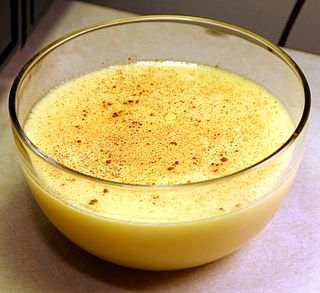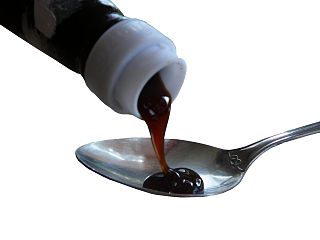
Dessert is a course that concludes a meal. The course consists of sweet foods, such as cake, and possibly a beverage such as dessert wine and liqueur. Some cultures sweeten foods that are more commonly savory to create desserts. In some parts of the world there is no tradition of a dessert course to conclude a meal.

Hominy is a food produced from dried maize (corn) kernels that have been treated with an alkali, in a process called nixtamalization. "Lye hominy" is a type of hominy made with lye.

Starch or amylum is a polymeric carbohydrate consisting of numerous glucose units joined by glycosidic bonds. This polysaccharide is produced by most green plants for energy storage. Worldwide, it is the most common carbohydrate in human diets, and is contained in large amounts in staple foods such as wheat, potatoes, maize (corn), rice, and cassava (manioc).

Flour is a powder made by grinding raw grains, roots, beans, nuts, or seeds. Flours are used to make many different foods. Cereal flour, particularly wheat flour, is the main ingredient of bread, which is a staple food for many cultures. Corn flour has been important in Mesoamerican cuisine since ancient times and remains a staple in the Americas. Rye flour is a constituent of bread in both Central Europe and Northern Europe.

Custard is a variety of culinary preparations based on sweetened milk, cheese, or cream cooked with egg or egg yolk to thicken it, and sometimes also flour, corn starch, or gelatin. Depending on the recipe, custard may vary in consistency from a thin pouring sauce to the thick pastry cream used to fill éclairs. The most common custards are used in custard desserts or dessert sauces and typically include sugar and vanilla; however, savory custards are also found, e.g., in quiche.

Corn syrup is a food syrup which is made from the starch of corn/maize and contains varying amounts of sugars: glucose, maltose and higher oligosaccharides, depending on the grade. Corn syrup is used in foods to soften texture, add volume, prevent crystallization of sugar, and enhance flavor. It can be processed into high-fructose corn syrup (HFCS) by using the enzyme D-xylose isomerase to convert a large proportion of its glucose into sweeter fructose.

Porridge is a food made by heating or boiling ground, crushed or chopped starchy plants, typically grain, in milk or water. It is often cooked or served with added flavourings such as sugar, honey, fruit, or syrup to make a sweet cereal, or it can be mixed with spices, meat, or vegetables to make a savoury dish. It is usually served hot in a bowl, depending on its consistency. Oat porridge, or oatmeal, is one of the most common types of porridge. Gruel is a thinner version of porridge and congee is a savoury variation of porridge of Asian origin.

Gravy is a topping or sauce often made from the juices of meats that run naturally during cooking and often thickened with corn starch or other thickeners for added texture. The gravy may be further coloured and flavoured with gravy salt or gravy browning or ready-made cubes. Powders can be used as a substitute for natural meat or vegetable extracts. Canned and instant gravies are also available. Gravy is commonly served with roasts, meatloaf, rice, noodles, chips (fries), mashed potatoes, or biscuits.

Sweet corn, also called sweetcorn, sugar corn and pole corn, is a variety of corn grown for human consumption with a high sugar content. Sweet corn is the result of a naturally occurring recessive mutation in the genes which control conversion of sugar to starch inside the endosperm of the corn kernel. Sweet corn is picked when still immature and prepared and eaten as a vegetable, rather than field corn, which is harvested when the kernels are dry and mature. Since the process of maturation involves converting sugar to starch, sweet corn stores poorly and must be eaten fresh, canned, or frozen, before the kernels become tough and starchy.

Pudding is a type of food. It can be either a dessert, served after the main meal, or a savoury dish, served as part of the main meal.

Bird's Custard is the brand name for the original powdered, egg-free imitation custard powder, now owned by Premier Foods. Custard powder and instant custard powder are the generic product names for similar and competing products. The product is a powder, based on cornflour, which thickens to form a custard-like sauce when mixed with milk and heated.
Cornflour or corn flour may refer to:

Chocolate puddings are a class of desserts in the pudding family with chocolate flavors. There are two main types: a boiled then chilled dessert, texturally a custard set with starch, commonly eaten in the U.S., Canada, Germany, Sweden, Poland, and East and South East Asia; and a steamed/baked version, texturally similar to cake, popular in the UK, Ireland, Australia, Germany and New Zealand.

A thickening agent or thickener is a substance which can increase the viscosity of a liquid without substantially changing its other properties. Edible thickeners are commonly used to thicken sauces, soups, and puddings without altering their taste; thickeners are also used in paints, inks, explosives, and cosmetics.

Belizean cuisine is an amalgamation of all ethnicities in the nation of Belize and their respectively wide variety of foods. Breakfast often consists of sides of bread, flour tortillas, or fry jacks that are often homemade and eaten with various cheeses. All are often accompanied with refried beans, cheeses, and various forms of eggs, etc. Inclusive is also cereal along with milk, coffee, or tea.

Mazamorra or masamorra is the name for numerous traditional dishes from the Iberian Peninsula and Hispanic America.
Arrowroot is a starch obtained from the rhizomes (rootstock) of several tropical plants, traditionally Maranta arundinacea, but also Florida arrowroot from Zamia integrifolia, and tapioca from cassava, which is often labeled arrowroot. Polynesian arrowroot or pia, and Japanese arrowroot, also called kudzu, are used in similar ways. In India, it is called palua.

Oyster sauce describes a number of sauces made by cooking oysters. The most common in modern use is a viscous dark brown condiment made from oyster extracts, sugar, salt and water, thickened with corn starch.



















